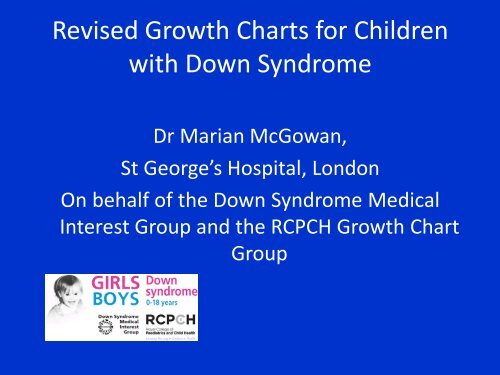Revised Growth Charts for Children with Down Syndrome
Revised Growth Charts for Children with Down Syndrome
Revised Growth Charts for Children with Down Syndrome
- No tags were found...
You also want an ePaper? Increase the reach of your titles
YUMPU automatically turns print PDFs into web optimized ePapers that Google loves.
<strong>Revised</strong> <strong>Growth</strong> <strong>Charts</strong> <strong>for</strong> <strong>Children</strong><strong>with</strong> <strong>Down</strong> <strong>Syndrome</strong>Dr Marian McGowan,St George’s Hospital, LondonOn behalf of the <strong>Down</strong> <strong>Syndrome</strong> MedicalInterest Group and the RCPCH <strong>Growth</strong> ChartGroup
What is a growth chart?• A tool <strong>for</strong> recording serial measurements• A pictorial method of assessing a child’sgrowth trend• A way of comparing a child’s growth pattern tothat of the population
<strong>Growth</strong> in children <strong>with</strong> <strong>Down</strong>syndrome• Babies <strong>with</strong> <strong>Down</strong> syndrome are born earlier(average 38 weeks)• They may take longer than other babies to get backto their birth weight• <strong>Children</strong> and adults <strong>with</strong> <strong>Down</strong> syndrome tend to beshort• High prevalence of overweight/obesity• Pubertal growth spurt starts on average1 year earlier & is less pronounced
Why special charts <strong>for</strong> children <strong>with</strong><strong>Down</strong> syndrome?• Shorter than general population – dedicatedcharts enable comparison <strong>with</strong> peer group• Increased risk of additional medical conditions• Regular growth monitoring and plotting onappropriate charts can give early indication ofproblems
Problems that can affect growth• Congenital heart disease• Severe gastro-oesophageal reflux• Oral motor feeding difficulties• Sleep related upper airway obstruction• Coeliac disease• Emotional/physical deprivation & neglect
History : <strong>Down</strong> <strong>Syndrome</strong>/DSMIG• US 1988• Sicily 1990• Holland 1996• UK growth charts 2002
The data• Healthy children <strong>with</strong> <strong>Down</strong> syndrome(congenital heart disease and other majormorbidity excluded)• 15 areas in UK and 1 in ROI• 1089 children• 5913 measurements
History: RCPCH and growthcharts2008 RCPCH commissioned to design new pre schoolcharts to incorporate new WHO standard2009 Implemention in England, train the trainersessions, supporting educational materials, chartimages and source data all available via Website /RCPCH2010 UK-WHO adopted by Scotland, NI, Wales, NewZealand, Eire; work on school age charts begins,educational materials revised, papers written
BMI look up• No calculation• Separate chart notneeded
History : DSMIG• UK growth charts 2002• New PCHR insert 2011• Re<strong>for</strong>matted charts, using same data butcon<strong>for</strong>ming to UK90-WHO layout, 2011• RCPCH approval 2012• Available from Harlow Printing
What’s new?• Expanded section <strong>for</strong> ages 0 to 6 months• - 4 SD “low line” <strong>for</strong> monitoring exceptionallysmall children• BMI “look-up” chart
How to use the redesigned charts• Plot measurements from term• For pre-term babies use standard UK90Neonatal and Infant Close Monitoring Chart• Use BMI conversion chart to assess weightespecially <strong>for</strong> those in upper centilesFor this populationBMI > 75 th centile = overweight> 91 st centile = obese
NICM chart:• Large scale• SD low lines <strong>for</strong> assessmentof very small infants• Date boxes
Infants and toddlersBody Mass Index (BMI) lookup• Read off the weight andheight centiles from thegrowth chart.• Plot the weight centile(left axis) against theheight centile (bottomaxis)• Read off thecorresponding BMIcentile from the slantinglines.• Record centile <strong>with</strong> datein the data box• Accurate to 1/4 ¼ centilespaceBMI = 91st© 2009 Royal College of Paediatrics and Child Healthwwwgrowthcharts.rcpch.ac.uk
Weight-height conversion chart <strong>for</strong><strong>Down</strong> <strong>Syndrome</strong>91752
<strong>Charts</strong> are a tool• And need to be interpreted• Use alongside clinical assessment of child’swellbeing• Healthy babies may lose > 10% of their birthweight and take up to 4 weeks to regain birthweight• After 4 weeks most babies’ weight tracks <strong>with</strong>inone centile space …BUT• Pay careful attention to babies that are growingslowly – consider overall health AND possiblefeeding problems
More in<strong>for</strong>mation…• www.dsmig.org.uk• www.growthcharts.rcpch.ac.uk(educational materials)• www.harlowprinting.co.uk
Thanks to
Thanks to:DSMIGDr Mary StylesDr Jennifer DennisDr Jill EllisDr Liz MarderHarlow PrintingRCPCH <strong>Growth</strong> ChartCommitteeProfessor Charlotte WrightProfessor Tim ColeJyotsna VohraKarina PallMr John Short andstaff












